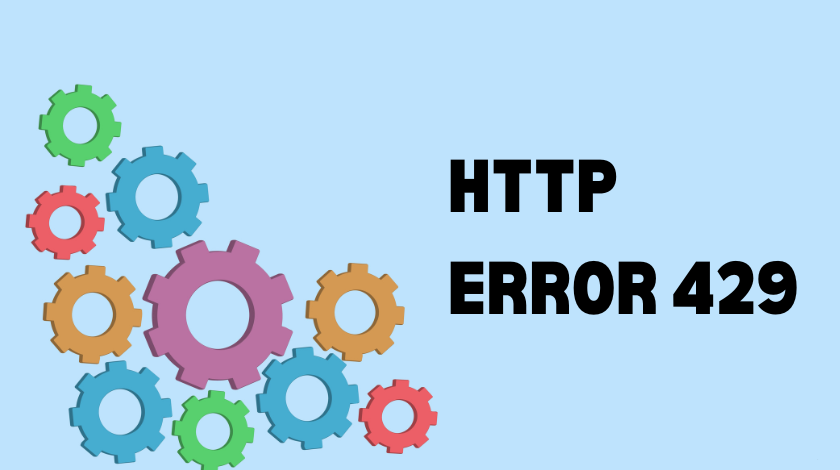HTTP Error 429: A Complete Beginner-Friendly Guide
If you’ve been browsing the internet or working with APIs, there’s a good chance you’ve run into HTTP Error 429. It usually pops up with a message like:
-
“429 Too Many Requests”
-
“Rate limit exceeded”
At first, it can feel confusing or even frustrating. Why is the website suddenly blocking you? Did you do something wrong?
Don’t worry. In this guide, I’ll break down everything you need to know about HTTP Error 429 in simple terms. We’ll look at why it happens, how to fix it, and even how I’ve personally dealt with it in my own projects.
By the end, you’ll not only understand this error but also know how to prevent it from messing with your browsing, apps, or website.
What Is HTTP Error 429?
The official name of HTTP Error 429 is:
“429 Too Many Requests.”
In plain English, this error means:
You’ve made too many requests to a server in a short period of time, and now the server is asking you to slow down.
It’s like when you keep calling a friend back-to-back without waiting for them to call you. Eventually, they’ll stop answering and tell you, “Give me a break.”
That’s exactly what a website or API does with error 429—it’s protecting itself from being overloaded.
Why Does HTTP Error 429 Happen?
There are a few main reasons why you might see this error. Let’s break them down.
1. Rate Limiting
Most websites and APIs set a limit on how many requests you can make in a given timeframe.
Example:
-
100 requests per minute
-
1000 requests per hour
If you go over the limit, you’ll get HTTP Error 429.
2. Bots or Automation
If you’re using scripts, scrapers, or automated tools to access a site, you’re more likely to hit the limit. Sites often restrict automation to prevent abuse.
3. Shared Networks
Sometimes, you didn’t even do anything wrong. If you’re on a shared network (like public Wi-Fi), other people might also be sending requests. The server sees all traffic from the same IP and flags it.
4. Misconfigured Plugins or Apps
On websites (especially WordPress), certain plugins or poorly configured apps can cause repeated requests that overwhelm the server. This can trigger 429 errors even for normal visitors.
Real-Life Example: My First Time Seeing Error 429
The first time I saw an HTTP 429 error was while testing a small weather API for a side project. I was excited and set up my code to fetch data every second.
Within a minute, boom: 429 Too Many Requests.
At first, I thought my code was broken. But after checking the API’s documentation, I realized they only allowed 60 requests per minute. My script was hitting 60 requests in a single minute, so the server simply told me to slow down.
It was a learning moment. I adjusted my code to fetch once every 60 seconds, and the problem disappeared.
Moral of the story? HTTP 429 is not always an error—it’s often a signal to play by the rules.
How HTTP Error 429 Affects You
Depending on who you are, this error impacts you differently.
1. Regular Users
If you’re just browsing and see this error, it usually means:
-
The site thinks you’re sending too many requests.
-
Or the server is overloaded.
It can be frustrating, but usually temporary.
2. Developers
For developers, 429 is a sign to adjust code or add logic to respect rate limits. Ignoring it can break your app or get your IP blocked.
3. Website Owners
If visitors frequently see 429 on your site, it can hurt:
-
User experience
-
SEO rankings (Google doesn’t like inaccessible sites)
-
Your reputation
So fixing it is important.
Common Situations Where You’ll See HTTP Error 429
-
APIs: Weather, finance, Google Maps, or Twitter APIs often enforce strict rate limits.
-
WordPress sites: Certain plugins may trigger repeated requests.
-
Scraping or automation: Tools that send hundreds of requests quickly will hit limits.
-
Cloud services: Platforms like AWS, Azure, or Google Cloud enforce quotas.
How to Fix HTTP Error 429 (As a User)
If you’re just visiting a site and suddenly see this error, here are a few simple things to try:
-
Wait and Refresh
-
The simplest fix. Servers usually reset after a short time.
-
-
Restart Your Browser or App
-
Sometimes cached sessions cause repeat requests. Restarting helps.
-
-
Change Networks
-
Switch from Wi-Fi to mobile data. This changes your IP and may bypass the block.
-
-
Disable Extensions
-
Browser add-ons or scripts may be sending extra requests.
-
-
Contact Support
-
If the problem persists on one site, reach out to the website’s team.
-
How to Fix HTTP Error 429 (As a Developer)
Developers have more control, but also more responsibility. Here’s what you can do:
1. Respect Rate Limits
Always check the API documentation. Most APIs clearly mention:
-
Requests allowed per second/minute/hour
-
How to handle retries
2. Use Backoff Strategies
Instead of retrying instantly, wait longer between retries. Two common strategies are:
-
Exponential backoff: Wait 1s, then 2s, then 4s, then 8s, etc.
-
Fixed backoff: Wait the same amount of time between retries.
3. Cache Responses
If you’re requesting the same data repeatedly, store it locally instead of calling the server again.
4. Check Response Headers
Servers often send back helpful headers with a 429 error, like:
-
Retry-After: 30
This means “Wait 30 seconds before trying again.”
5. Distribute Requests
If you’re running apps on multiple servers, spread requests across them instead of overwhelming one IP.
Fixing HTTP Error 429 in WordPress
If you’re a WordPress site owner, you might run into this error without realizing why. Here are some common causes and fixes:
Causes:
-
Too many login attempts (security plugins blocking brute force)
-
Overactive plugins making external requests
-
Bots crawling your site too aggressively
Fixes:
-
Limit Login Attempts: Use a security plugin with proper configuration.
-
Audit Plugins: Disable unnecessary plugins or update them.
-
Enable Caching: Use caching plugins to reduce server load.
-
Talk to Your Host: Sometimes, it’s an issue with server rate limits.
Preventing HTTP Error 429
Here are practical tips to avoid running into this error often:
-
Don’t spam refresh when a site is slow.
-
If using APIs, always follow their guidelines.
-
Use delays in automation tools.
-
Set up caching and optimize your site if you’re an owner.
-
Monitor traffic logs to catch unusual request spikes.
SEO Impact of HTTP Error 429
If Googlebot or other crawlers frequently get a 429 on your site, it can affect SEO. Why?
-
Search engines may crawl your site less often.
-
Important pages might not get indexed.
-
Rankings could drop if the site appears unreliable.
Solution:
-
Check Google Search Console for crawl errors.
-
Configure your server to allow search engine crawlers properly.
-
Use caching and CDN services to handle high traffic.
Personal Takeaway
After years of working with websites and APIs, I’ve come to see HTTP Error 429 not as a problem but as a safeguard. It’s the internet’s polite way of saying:
“Slow down. Let’s keep things fair and stable.”
The first time I hit this error, I was annoyed. But now, I see it as a reminder to respect resources—whether it’s someone’s server, an API, or even my own site’s hosting plan.
If you’re facing this error right now, don’t stress. A little patience and a few tweaks usually solve it. And if you’re building apps or running a website, treating HTTP Error 429 with care will make your users’ experience smoother and your system more reliable.
Final Thoughts
To sum it up:
-
HTTP Error 429 = “Too Many Requests.”
-
It happens when you exceed rate limits.
-
Users can usually fix it by waiting or switching networks.
-
Developers and site owners need to implement smarter request handling.
-
It’s not a bug—it’s a protection mechanism.
The internet is a shared space. Think of HTTP 429 as a gentle reminder to share responsibly.





